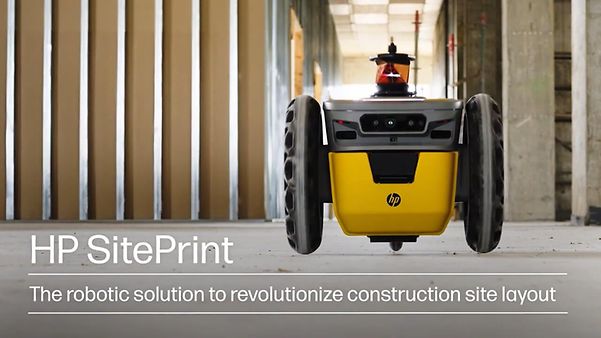HP Robotic Solution Accelerates Construction Process
How an end-to-end robotic solution is revolutionising the complex layout process on construction sites and reducing time and costs in construction projects.

In brief
- An autonomous HP SitePrint printing robot automates layout and marking directly on the shell floor at construction sites – at up to six times the speed of manual methods.
- The robot uses LiDAR, sensors and integration with total stations to detect obstacles and navigate precisely; CAD plans are obtained from the cloud and changes can be played back in real time.
- The solution reduces errors and rework, lowers personnel costs and, thanks to mobile connectivity, can be used worldwide – without additional contracts thanks to global IoT networks.
Autonomous layout: How HP's SitePrint robot makes construction projects faster and cheaper
Time is a crucial factor in the construction industry: delays usually lead to additional costs for those involved in the project. There are numerous prominent examples that demonstrate how construction sites are unpredictable in the truest sense of the word – from Stuttgart 21 railway station and the Elbphilharmonie concert hall to BER Airport and the Pergamon Museum. Only 30 percent of all construction projects are completed on time and within budget. This is partly because construction is a craft, involving many manual tasks and therefore sometimes prone to errors.
According to the ‘State of Construction Productivity 2023’ survey conducted by technology group HP, 60 percent of construction workers and decision-makers surveyed believe that techniques and processes have hardly changed in the last 20 to 30 years. Demand for digitalisation on construction sites is growing: two out of three respondents would like to automate layout tasks such as marking floor plans, for example. The survey also found that layout errors lead to delays of two weeks on average, which corresponds to a loss of 19 per cent of the average profit margin on a project. Printing specialist HP has therefore developed a small mobile robot called ‘SitePrint’ that autonomously draws floor plans, markings and even text directly onto the floor of the building shell on construction sites.
Similar use case or any questions?
Simply fill out the contact form – we’ll get back to you as soon as possible.
Significantly faster layout creation than in the manual process
The HP SitePrint was used, for example, by the Spanish construction company Acciona during the construction of the Hospital Central do Alentejo in Évora, Portugal. This largest construction project in the country includes a ten-story building with 400 beds and all necessary functional units. The challenge was to precisely mark almost two kilometers of drywall profiles on an area of about 8,400 square meters. Traditionally, this is done manually by a two-person team using tape measures and chalk lines. This process is time-consuming and error-prone.
To speed up this work, Acciona decided to use the HP SitePrint. The layout robot uses digital CAD drawings to automate the marking process, eliminating the need for manual measurements. The small vehicle was monitored by a single operator, while a technician prepared the documentation. This enabled a productivity rate of 225 m²/h compared to 40 m²/h using manual methods. The entire layout process was completed in 37.4 hours – six times faster than usual. This efficiency improvement allowed workers to start installing the walls earlier, ultimately leading to a faster project completion. In addition to saving time, the printing robot also helped reduce errors, as it offers an accuracy of less than three millimeters. This resulted in fewer reworks and lower overall costs.
Video: HP Site Print in action

Navigation via Laser and Connectivity via Mobile Network
The printing robot navigates around obstacles using sensors and LiDAR lasers and is connected to a total station commonly used on construction sites, which performs precise measurements of distances, angles, and heights. CAD plans can be uploaded to the system from the cloud and controlled on-site via tablet; the operator can upload changes to the construction plan back to the cloud in real-time. This way, all stakeholders are always informed about the current status of the process. Additionally, this connectivity allows notifications about the robot's status or ink tank levels to be immediately transmitted to the service team.
Since the system is connected via Telekom's LTE mobile network – WLAN or fixed network are not available in shell constructions – HP can distribute and use its autonomous printing robot internationally. The basis is Telekom's global mobile network, which guarantees reliable and secure connectivity through its own networks, such as in Germany, as well as through roaming agreements with more than 600 partners worldwide. Thus, HP has already supported construction projects worldwide – from Düsseldorf to Badalona in Spain and San Angelo in Texas to the US Virgin Islands in the Caribbean or the remote province of Nunavut in northern Canada. And without having to set up new contracts each time, but with a central contact person providing true global connectivity – a clear efficiency advantage.
HP SitePrint: Advantages at a Glance
- Time savings: HP’s robotic solution accelerates complex construction site layouts, delivering up to 10x the productivity of manual techniques.
- Cost efficiency: Labor costs decrease, and costly reworks are avoided.
- Personnel deployment: Only one operator is required – an important factor during skilled labor shortages. The remaining team members are available for other tasks.
- Detail accuracy: Marking precision increases to up to 3 mm, facilitating the construction process.
- Error reduction: Measurement errors and associated problems are minimized.
- Flexibility: Short-term changes can be integrated without time loss.
Availability: Thanks to connectivity via Telekom's mobile network, the robot can be used worldwide.
Valuable Helper in Exhibition Construction
HP SitePrint can also be used for other application areas involving layout tasks. The Berlin-based ArtLab Studios, specialized in light design and event technology, had to set up a large booth at the Düsseldorf trade fair. This involved the precise measurement and marking of locations for lighting, sound, and electrical systems on an area of 8,000 square meters. Traditionally, this task requires a large team of specialists working with printed floor plans and tape measures. Especially for temporary events like a trade fair, the available time for setup is often limited, creating additional pressure.
The HP SitePrint also automated this layout process, requiring only one person to operate the printer. ArtLab was able to complete the work in 9 instead of 16 hours, cutting time requirements by nearly half. The higher detail accuracy of the markings also reduced errors and associated reworks. Additionally, short-term changes could be easily integrated without jeopardizing the schedule.
Speaking of trade fairs: HP will demonstrate its printing robot at Digital X 2024 in Cologne on September 18 and 19. Europe's largest digitalization event also offers many other successful best practices from the Connected Business sector for visitors, as well as panel discussions, masterclasses, and the opportunity to network with digital pioneers.
IoT Connectivity

IoT Connectivity
The right IoT connectivity coordinates IoT connections across platforms, integrates devices and data via API, and enables global control with the highest security standards. You can manage your IoT projects flexibly, efficiently, and independently of manufacturers.

Ümit Günes
Marketing Manager IoT
Having been with Telekom since 2008, Ümit possesses a comprehensive understanding of various facets of the Internet of Things. He has a keen interest in the digital transformation of the business world. On this blog, he shares insights into the latest developments and trends in the IoT sector that provide genuine value to customers.